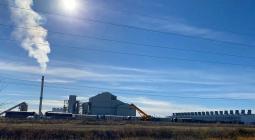Microsoft cuts its direct footprint, but its supply chain emissions went up in 2021
Despite Microsoft's commitment to be carbon negative by 2030, Scope 3 emissions are difficult to control.
Microsoft has cut emissions from its own operations by 17 percent in 2021, but this was dwarfed by increases in "Scope 3" emissions from its supply chain, according to its latest sustainability report.
Responding to the detail in the report, Microsoft executives explained that the company is well on its way to eliminating the Scope 1 and 2 emissions which are directly within its control, but Scope 3 emissions originate with Microsoft's customers and partners and will be harder to eliminate. The company's plan is to reduce its own emissions to zero, to persuade its partners to help cut Scope 3 emissions by 50 percent - and then rely on carbon removal to become carbon negative. In 2021, the company paid to have 1.4 million metric tons of carbon removed from the air and plans to buy 1.5m metric tons in 2022.
During 2021, Microsoft also certified that two of its data centers produce zero waste, bringing its total of Zero Waste data centers to four.
Lessons to learn
"Our strategy to reach carbon negative by 2030 is relatively simple—we will reduce our Scope 1 and 2 emissions to near zero by improving efficiency, adopting new solutions, and purchasing zero-carbon energy. We are engaging suppliers and our business groups to cut our Scope 3 emissions by more than 50 percent and we’ll rely on carbon removal to reach carbon negative," said Brad Smith, President and Vice Chair, and Lucas Joppa, Chief Environmental Officer in the report.
"This year’s report includes several important lessons," they explain in a blog post: "We saw an overall reduction in our Scope 1 and Scope 2 emissions of about 17 percent year over year, through our purchasing of renewable energy. At the same time, we saw a rise in our Scope 3 emissions, which increased about 23 percent year over year."
As a diagram in the report makes clear, this is increase is far bigger than the reduction Microsoft achieved in its own Scope 1 and 2 emissions. Scope 3 emissions are usually a much greater part of any company's footprint and in Microsoft's case, these emissions include the concrete used in buildings, the embodied emissions in equipment the company purchased, the emissions used in delivering physical products, and the energy used by Xboxes and other devices in the home.
Microsoft's Scope 3 emissions add up to about 50 times the emissions Microsoft is responsible for in its own premises, and the emissions from the electricity it uses (Scope 1 and Scope 2) so a 23 percent increase in this part of Microsoft's footprint is more than 50 times the amount the company saved within Scope 1 and 2.
"We work to limit [Scope 3] emissions when we design and manufacture our products, and work with our suppliers to report and reduce their emissions—but still saw an increase," said the pair. "This serves as an important reminder that Scope 3 emissions are the most difficult to control and reduce."
One problem is that Microsoft's business has been expanding: "Our emissions outputs took place against a backdrop of significant business growth in 2021," the pair say. "In this time period our business revenue grew by 20 percent. We significantly expanded our global data center footprint to meet the increased demand for Microsoft’s cloud business and we saw a growth in devices sales, especially Xbox and associated usage due in part to the pandemic."
Microsoft's capital equipment - including data centers, office space, and new equipment such as servers - made up about 30 percent of its Scope 3 emissions. This equipment surged this year, because of growing demand.
Another 29 percent of the Scope 3 emissions was from using Microsoft Xbox and Surface devices. "Around the world, the electricity used to power devices today largely comes from grids reliant on carbon-intensive sources such as coal or gas, so Microsoft must account for that carbon for the lifetime of our devices to accurately track our Scope 3 emissions," Smith and Joppa point out. The total for this part of Microsoft's Scope 3 emissions takes account of the carbon intensity of the grid wherever each device is sold.
"Our experience this year highlights a few takeaways relevant to many organizations executing against their sustainability commitments," the pair said. "Progress won’t always be linear. The rate at which we can implement emissions reductions is dependent on many factors that can fluctuate over time, ranging from our own business growth and supplier mix to the rate of growth of green infrastructure, such as the supply of and transition speed to renewable energy."
Different emissions sources may get addressed at different times, and companies may see emissions rise and fall year on year, the report said: "Nonetheless, the challenge remains: we must continuously improve on our efforts to decouple our emissions from our growth until we reach our carbon-negative commitment in 2030."
Among the initiatives the company promised, were a shift to a 100 percent electric campus vehicle fleet, phasing out diesel fuel as a backup energy source at data centers, and the carbon saved through waste reduction and moves to support a circular economy. The company also said it will offer a "renewable energy purchasing program to cover the energy consumption of our consumer devices" and will work with suppliers to help them reduce their emissions.
Construction will be improved by the purchase of "green steel and low carbo
Construction will be improved by the purchase of "green steel and low carbon concrete."
Microsoft now requires its suppliers to report their emissions, and has data from 87 percent of its suppliers, hence the detail in its Scope 3 reporting. It also launched the Carbon Call, demanding more rigorous carbon accounting standards.
Carbon removal, water and more
To balance the Scope 3 emissions, Microsoft hopes to ramp up carbon removal technologies. In 2014, it paid to have 1.4 million metric tons of carbon removed from the atmosphere, "Looking ahead, we will set even bolder carbon removal targets, and we will continue to increase our contracted volume year over year through 2030. This has an added impact of helping drive greater market maturation in carbon removal – an advance sorely needed."
Within Microsoft, the company accounts for business travel, as part of its Scope 3 emissions, and will increase the internal carbon accounting fee to $100 per mtCO2e this year, which will help support the purchase of sustainable aviation fuel, for instance from the LanzaJet plant in which Microsoft has invested.
While the carbon section of the report will get most attention, Microsoft also included work to become water positive, to eliminate waste, and to support ecosystems.
In 2021, the company matched 45 percent of the water it used. This figure has been increasing, but in 2021 was a decline from the figure of 49 percent in 2020, due to the expansion of the company.
In waste, the company reached a total of 78.4 percent of its waste diverted from landfill, with strong increases in reuse. However there was a hiccup in the rate of reuse of server hardware, which fell from 87 percent to 76 percent, because of "a reduction in the volume of decommissioned assets and increase in the volume of recyclable material in the mix".
Author:Peter Judge




